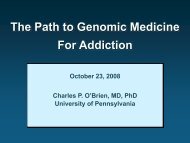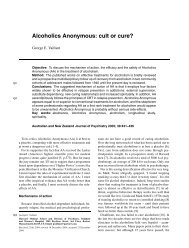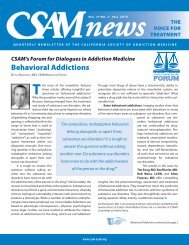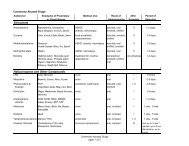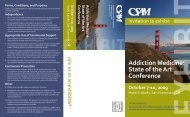SAN FRANCISCOMEDICINE - California Society of Addiction ...
SAN FRANCISCOMEDICINE - California Society of Addiction ...
SAN FRANCISCOMEDICINE - California Society of Addiction ...
You also want an ePaper? Increase the reach of your titles
YUMPU automatically turns print PDFs into web optimized ePapers that Google loves.
Public Health Report<br />
Robert P. Cabaj, MD, and David Hersh, MD<br />
SFDPH Public Sector Services for<br />
Substance Use Disorders<br />
San Francisco citizens have a wide array <strong>of</strong> services to help<br />
with substance use-related problems and disorders. Primarily<br />
targeted for people with little or no insurance or<br />
who are covered by Medi-Cal, Medicare, or a combination <strong>of</strong> the<br />
two, services range from substance use assessments, treatment<br />
planning, and brief interventions at the extensive Department <strong>of</strong><br />
Public Health (DPH) Community Oriented Primary Care Clinics<br />
(COPC) to the network <strong>of</strong> specialized substance abuse treatment<br />
modalities for serious and persistent substance abusers <strong>of</strong>fered<br />
through DPH Community Behavioral Health Services (CBHS).<br />
The specialty substance abuse services are provided mainly<br />
by community-based organizations, under contracts with CBHS.<br />
Since 2000, San Francisco has had an <strong>of</strong>ficial Harm Reduction<br />
Policy that applies to the health department and all contractors<br />
who deliver substance use, mental health, sexually transmitted<br />
diseases, and HIV/AIDS treatment and prevention services, and/<br />
or who serve drug and alcohol users in their programs. In addition,<br />
since 2003, when CBHS was organized by combining mental health<br />
and substance abuse administrations, the vision <strong>of</strong> the Department<br />
has been, “Any door is the right door”—meaning that any client<br />
or family seeking services can be seen and assessed at any site<br />
operated by or contracted to CBHS. If a particular program does<br />
not <strong>of</strong>fer the level <strong>of</strong> care needed, that program will make sure<br />
the client or family is referred to the proper site and engaged. An<br />
open-access policy means all people seeking help will be seen in<br />
forty-eight hours or less, so there are no waiting lists except at some<br />
residential care programs. If a client has to wait for a residential<br />
program, he or she will still be engaged by the referring provider<br />
with support services.<br />
People can seek services by walking into any community<br />
clinic or by going to the Behavioral Health Access Center at 1380<br />
Howard Street (at 10th Street), which houses the Treatment<br />
Access Program (which serves as the gatekeeper for residential<br />
services) and the Access Team (which screens for mental health<br />
and substance abuse concerns). People can also get information or<br />
be screened for referrals by telephoning the central access line at<br />
(415) 255-3737. Other ways <strong>of</strong> accessing care are through any <strong>of</strong><br />
the COPC sites and through programs such as the Homeless Outreach<br />
Team and Project Homeless Connect, which target homeless<br />
clients who <strong>of</strong>ten need substance-abuse services.<br />
To better coordinate patient assessment and placement into<br />
the City’s wide array <strong>of</strong> funded substance use, dual diagnosis,<br />
and mental health services, the Behavioral Health Access Center<br />
(BHAC) was created in 2008. The BHAC represents the colocation<br />
and integration <strong>of</strong> several formally separate City substance<br />
use and mental health evaluation, stabilization, and treatmentlinkage<br />
services, including the Treatment Access Program (general<br />
substance use and dual diagnosis), Centralized Opiate Program<br />
Evaluation (COPE) Service (methadone and buprenorphine),<br />
Mental Health Access Program, and the Buprenorphine Induction<br />
Clinic. The CBHS Pharmacy, also housed at BHAC, provides<br />
psychotropic medications to patients seen at City mental health<br />
clinics and BHAC, as well as Suboxone to patients enrolled in the<br />
City’s buprenorphine program.<br />
Patients presenting to BHAC receive a thorough biopsychosocial<br />
assessment that guides the determination <strong>of</strong> the level <strong>of</strong> care<br />
and treatment modality most likely to meet the patients’ needs. In<br />
addition, staff give consideration to which specific programs would<br />
best meet each patient’s particular needs, taking into account such<br />
factors as gender, language capacity, ethnicity, race, sexual orientation,<br />
housing needs, family connections, and other relevant factors.<br />
DPH provides funding for primary and secondary prevention,<br />
detoxification (social model and residential medically assisted),<br />
outpatient (intensive and low-intensity, including medication<br />
management and smoking cessation treatment), opiate agonist<br />
treatment (methadone and buprenorphine), drop-in, drug court<br />
and other criminal justice follow-up, and residential (substanceuse,<br />
dual diagnosis, mental health) services. Patients are referred<br />
to BHAC from programs and services across the City, including<br />
primary care, mental health, case-management, substance-use,<br />
and homeless outreach.<br />
DPH funds thousands <strong>of</strong> treatment slots and beds across the<br />
City, including more than 2,200 methadone and 200 buprenorphine<br />
maintenance slots. To expand and enhance access to these<br />
opiate-agonist treatment services, DPH has implemented several<br />
extremely innovative programs, including a Mobile Methadone<br />
Van, an Office-Based Methadone Pilot Program (also known as <strong>of</strong>fice-based<br />
opiate treatment or OBOT), a centralized opiate agonist<br />
treatment assessment/linkage service (COPE), and the Integrated<br />
Buprenorphine Intervention Service (IBIS). The methadone vans<br />
www.sfms.org June 2010 San Francisco Medicine 37




